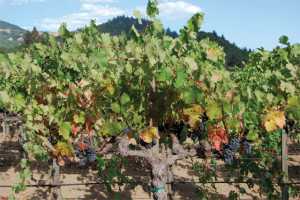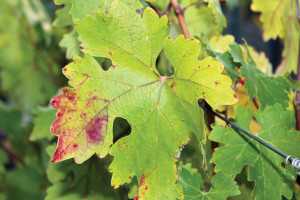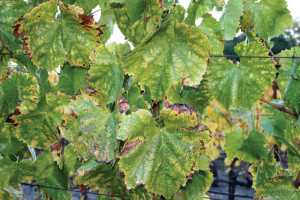Disease Management: Red Blotch Update
Editor’s Note: Rhonda Smith ([email protected]) is a University of California Cooperative Extension viticulture farm advisor in Sonoma County. Dr. Mysore Sudarshana is a USDA-Agricultural Research Service research biologist in Davis, CA.

This Cabernet Franc vine photo taken in September 2011, shows symptoms of red blotch. (Photo credit: University of California Cooperative Extension)
In 2011, a new grapevine virus was discovered in red winegrape varieties showing symptoms that occasionally had been confused with grapevine leafroll disease. Grapevine red blotch associated virus (GRBaV) has been confirmed in both red and white varieties within California and in seven other states. Disease symptoms include progressive change in the color of the leaf blade in both red and white varieties and a delay in sugar accumulation. Preliminary evaluations indicate reduced acidity at harvest.
Disease Symptoms
In red varieties grown on California’s North Coast, the first signs of red coloration in basal leaf blades occur as early as June, but onset is more commonly seen in August. Observations of vine canopies indicate that grapevines testing positive for GRBaV have leaf blades with irregular red blotches either at the margins, (e.g. Merlot) or close to the veins (Cabernet Franc and Cabernet Sauvignon). These varieties as well as Pinot Noir may also have blades with red veins without interveinal reddening, although as the season progresses, the majority of symptomatic blades turn at least partially red. Vines with leaf blades that only display red veins without other reddening should be observed to note the onset of additional symptoms.
Red blotch disease symptoms in leaves of white fruit varieties are more difficult to identify than in red varieties. A one-size-fits-all observation across many varieties is the similarity of disease symptoms with severe late-season potassium deficiency symptoms. In Chardonnay, irregular chlorotic areas of leaf blades can be seen in July. By late August interveinal chlorosis is more apparent, and areas along the margins of blades are very chlorotic. On the north coast, by late September, regions of the blade with severe chlorosis become necrotic.
Disease History

This Cabernet Sauvignon leaf photo, taken in October 2013, shows symptoms of red blotch. (Photo credit: University of California Cooperative Extension)
Some North Coast growers have had experience with grapevine red blotch disease long before the disease was named or a virus was associated with the symptoms. Beginning in 2007, an increase in incidence of vines with red blotch symptoms was observed by grape growers in some Napa Valley vineyards. Grapevine leaf petiole and cane samples were collected from symptomatic vines by growers and University of California (UC) researchers and tested by commercial laboratories and UC-Davis Foundation Plant Services, respectively. Test results were most often negative for grapevine leafroll-associated viruses (GLRaVs).
In fall 2011, a new circular DNA virus — later named GRBaV — was identified by USDA-Agricultural Research Service and UC-Davis virologists in diseased vines of Cabernet Sauvignon, Cabernet Franc, and Zinfandel. This new virus is nearly identical to a DNA virus isolated by Cornell University virologists from a Cabernet Franc vine. To identify the new virus, the researchers at Davis utilized next generation (“deep”) sequencing technology. The process sequences all the genetic material (nucleic acid) in a plant sample and sorts it into known categories so that researchers can decide if what is left over is a new, previously unreported virus.
Determining Cause
Next generation sequencing may identify a new virus in a diseased grapevine; however, it does not mean the virus caused the disease. For example, Grapevine Syrah virus (GSyV-1) was identified using the same technology, yet thus far the virus has not been shown to cause Syrah decline or any other disease in grapevines. To prove an organism is the cause of a plant disease, plant pathologists working with bacteria and fungi must satisfy “Koch’s Postulates,” a process Robert Koch developed in 1890 — which was prior to the awareness of the existence of plant viruses.
To satisfy Koch’s Postulates, researchers must isolate the causal agent from a diseased host plant; insert just the agent into a host known to be free from that agent; observe the same disease symptoms in the host; then re-isolate the agent from the newly diseased host plant and verify it is identical to the agent that was inserted at the start of the process. Grape virologists are still challenged to apply the rules to a grapevine disease thought to be caused by a virus.
This year, virologists at Cornell University have proven that GRBaV is the cause of red blotch disease. Researchers satisfied Koch’s Postulates and were able to transmit the virus DNA into tissue-cultured grapevines that were free of known viruses, observe red blotch symptoms, and detect the same virus in symptomatic vines. This means that the effects of the disease on fruit and wine quality are likely due to the effects of the virus on fruit ripening physiology.
How It Spreads
Cornell researchers have identified the virus as a very unusual member of the family Geminiviridae. Some geminiviruses are spread between plants by leafhoppers while some are spread by whiteflies. At this time, it is not known if leafhoppers or other insects can vector GRBaV in the field. Virologists at Washington State University have determined that the virus can be moved to potted vines in the greenhouse by the Virginia creeper leafhopper.
Over the last three years, an increasing number of symptomatic vines have been mapped in specific blocks at the UC-Oakville Station in Napa County, a research vineyard managed by the UC-Davis Department of Viticulture and Enology. In other blocks at that location, directional spread is not evident. Some growers believe the number of diseased vines has increased over the years, whereas other growers are not willing to speculate, but just want to know if a vector is moving the virus. Bottom line: Researchers need time to learn what role insects play in spreading red blotch disease.
The virus is known to be spread by propagation. In 2011, UC-Davis virologists successfully grafted inoculated healthy potted vines with the virus by using chip buds taken from vines known to be infected with GRBaV. Preliminary evidence indicates that infected vines in first leaf vineyards may not show symptoms until the season following the first dormant period. At this time, all scion varieties and rootstock plants regardless of parentage are thought to be susceptible.
How To ID

This Chardonnay vine tested positive for the red blotch virus (GRBaV). (Photo credit: University of California Cooperative Extension)
The diagnostic test (a PCR assay) to detect GRBaV developed by the USDA-ARS group at Davis became available in October 2012, and since then commercial laboratories have processed thousands of samples submitted by growers. The virus has been confirmed in several varieties and counties in California and in the following states: Arizona, Idaho, Oregon, Washington, Georgia, New York, and Pennsylvania. It is also in Canada. At this time, vines infected with GRBaV have not been found in other countries.
In 2011 and 2012, samples were collected from individual symptomatic vines of red varieties in Napa, Sonoma, and San Luis Obispo counties. GRBaV was detected in about 95% of symptomatic grapevines and in about 2.7% of asymptomatic grapevines. This is an extremely high correlation between disease symptoms and the virus — higher than that between grapevine leafroll disease symptoms and leafroll associated viruses.
Although leaf blade symptoms in red varieties are highly correlated with GRBaV infection, other factors — in addition to grapevine leafroll disease — can cause somewhat similar symptoms. Red blades can be caused by mechanical damage or restrictions on the trunk or cordon or at the graft union. As described previously, the other consistent symptom of red blotch disease in the North Coast is a delay in sugar accumulation — even in years with moderate or warm temperatures. If a red or white variety is suspected to have red blotch disease, growers should sample suspect vines and have them tested for the presence of GRBaV.
It is critical to avoid establishing a vineyard block with untested wood. Bud wood collected this winter from mature vines for use in grafting or budding operations should test negative for GRBaV prior to use.
To verify the presence of the virus, samples must be collected and submitted to a commercial diagnostic lab for testing by PCR assay. Fall and winter are ideal for detecting many grapevine viruses and the basal portion of current year canes are submitted for testing. Contact the lab of your choice or visit their website for sample collection protocol. For a list of commercial labs in north and central California, visit http://cesonoma.ucanr.edu/files/27431.pdf. For plant diagnostic labs located in other regions, contact your local Cooperative Extension office.









